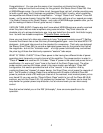
CLASS A / SIMUL-CLASS SWITCHES.
These two rocker switches on the 295's rear deck (again, one per channel) allow selection
of either the "Class A” Mode or the "Simul-Class" Mode. In Class A, the outer or end pairs of
power tubes (EL-34's) operate by themselves, while the inner or middle pairs (6L6's) remain
in "standby". The EL-34's are wired in a "Class A Triode" circuit for optimal warmth of tone,
and at lower output levels (about 30 watts per channel). The Class A mode is ideal for
recording, rehearsing, or any situation where you need great tone at low volumes. In the
"Simul-Class" Mode, all eight power tubes are operative (with the 6L6's adding about 65
watts of "Class AB" type power per channel) to produce a total of 95 watts per channel. It's
this combination of "Class A" warmth and "Class AB" efficiency that makes the Simul-Class
295 ideally suited as an instrument for guitar amplification.
POWER TUBES.
The power tubes used in the 295 are MESA STR-420 type 6L6 GC's, and MESA STR-440
type EL-34's. All MESA tubes are tested under high-voltage conditions and installed in
closely matched pairs. The 6L6's we use have very low 3rd harmonic output when
overdriven. The four inside sockets on the 295 should be fitted with these 6L6's. The EL-34
tubes are characterized by a more prominent harmonic output when driven hard; this
produces a brighter, more "grinding" high-end, usually preferred for guitar. The EL-34's are
used in the four outside or end sockets in the 295.
You can expect 6 months to 2 years (or more) of outstanding performance from your MESA
power tubes, depending on use. Tube wear is gradual and usually goes unnoticed until new
replacements are installed. Worn power tubes tend to sound flat with reduced punch, clarity
and high end. Occasional loss of power or sporadic blowing of fuses is nearly always
caused by troublesome power tubes. Often, you can spot the tube at fault and replace it
alone, at considerable savings over replacing all the output tubes. A tube that arcs or
"flashes over" inside should be replaced immediately. (In an emergency, you can just
remove the bad tube and go on with the show..."running on five cylinders."). Sometimes a
tube will "short out" intermittently, turning red-hot all over the large metal plate inside, but
usually a momentary switching off of the Standby or Power Switch will enable the tube to
straighten out its electron flow and return to proper operation. Should this happen
repeatedly, careful observation will usually reveal which tube is shorting, even though one
or two others may also turn red-hot after a few moments. Try to see which one is reddest or
turns red first - that is the bad one and the others are most likely unharmed. Internal circuitry
is built to withstand tube failure as much as possible; even if damage were to occur, it would
be minor and easily repaired.
When replacing tubes, please use only the MESA types specified. Using other tube brands
and/or types will invalidate your amplifier's warranty! To remove tubes, you must first push
back the black spring retainers clamped against the tube base. When reinstalling power
tubes, check that the spring clamps are making good contact with the tube base; bend them
in toward the center before plugging in the tube, if necessary. Avoid excessive wiggling of
the tubes when removing or installing them, as it can break off the small plastic key which
insures correct orientation of the tube in the socket.
4







